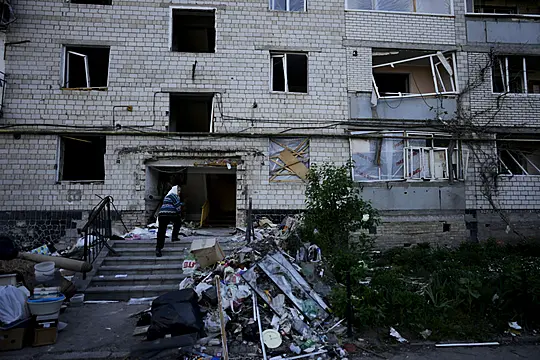A regional governor in eastern Ukraine says at least six civilians have been killed by the latest Russian shelling.
Luhansk region official Serhiy Haidai said another eight people were wounded in the shelling of the town of Sievierodonetsk over the previous 24 hours.
Sievierodonetsk is at the epicentre of fighting in Ukraine’s eastern industrial heartland of Donbas, where the Russian forces have been pressing their offensive despite stiff Ukrainian resistance.

Mr Haidai accused the Russians of deliberately targeting shelters where civilians were hiding.
People living in towns and villages near the front lines in Ukraine have been forced to hide in basements from constant shelling, struggling to survive with no electricity or gas – and often no running water.
But even in regions out of the range of the heavy guns, frequent air raid sirens wail as a constant reminder that a Russian missile can strike at any time — even for those walking their dogs, riding their bicycles and taking their children to parks in cities like Kyiv, Odesa and Lviv.
Curfews, checkpoints and fortifications are commonplace. So are fresh cemeteries, uprooted villagers and war-scarred landscapes, as Moscow intensifies its attacks in eastern and southern Ukraine.

“City residents are trying to return to regular life, but with every step, they stumble upon either a crater or a ruined house or a grave in the yard,” said 37-year-old engineer Andriy Pustovoi, speaking by phone to The Associated Press from the northern city of Chernihiv.
“No one is cooking food over a bonfire or drinking water from a river any more, but there’s a long way to go to a normal life.”
Chernihiv was in the way of Russian forces as they advanced toward Kyiv early in the war. It was heavily bombarded, and mayor Vladyslav Atroshenko said about half of its buildings were damaged or destroyed.

At least 700 residents were killed, and part of a city park now holds a cemetery, where some of them are buried.
Its streets are mostly empty now, half of the shops have not reopened and public transportation is not working properly, said Mr Pustovoi.
Rail service to Kyiv was only restored this month, but people who fled are in no rush to return.
“The scariest thing is that neighbouring Russia and Belarus are not going away from Chernihiv, which means that some of the residents that left when the war started may not come back,” Mr Atroshenko said.







